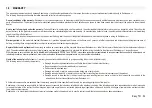
Easy Tilt 49
8.3
Disinfection and reuse of the wheelchair
When the wheelchair is used regularly, all surfaces that come into contact with the occupant should be treated frequently, or whenever the need arises, with a spray disinfectant.
It is not normally possible to guarantee the thorough disinfection of stitched seams.
We therefore recommend that the seat and backrest covers be changed and appropriately discarded in the event of bacterial contamination, in compliance with current regulations.
If the wheelchair is reused, the same type of treatment must be carried out very carefully before using the wheelchair again.
The first thing you should know is that
cleaning is not the same as disinfecting
. By cleaning we remove germs and dirt from surfaces, but we do not kill germs, although removing them decreases
the amount and risk of spreading infections. On the other hand, with a disinfection, what we do is kill microorganisms such as bacteria through using chemicals.
This process does not necessarily clean dirty surfaces, but by killing germs on the surface, it can further reduce the risk of spreading the infection.
Keeping that in mind, the correct process to follow with the wheelchair is to first perform
routine cleaning and then disinfect it
using a sanitary surface disinfectant.
These products are bactericidal and virucidal. You can find more information about these products on the website of the Ministry of Health or other reliable sources. We also recommend that you
carefully read the manufacturer's instructions for correct use and disinfection as well as to avoid possible contraindications.
8.4
Storage
If the wheelchair is not used for a medium-long period (over 4 months), it should be cleaned and stored in a dry and covered place and inside a box (preferably that of the original packaging). At the time of re-
use, it is necessary to carry out a general check of the wheelchair following the same points of paragraph 8.2. Before the occupant can use the wheelchair, carry out driving tests of the wheelchair to check for
defects. In case of malfunctions, faults or broken parts, consult an authorised dealer for the necessary repair.
8.5
Disposal/recycling of materials
When the wheelchair is to be disposed of (end of life of the product), it is necessary to consider any prevailing local regulations for waste disposal or recycling.
This includes cleaning or disinfecting the wheelchair before disposal.
A description of the materials used is provided
below.
•
Aluminium: frame, forks, wheels, backrest tubes, footplate tubes
•
Titanium: frame, backrest tubes
•
Steel: bolts and nuts, quick release axle
•
Plastic: footplates, side guards
•
Rubber/PU: grips, tyres, wheels
•
Carbon fibre: frame, side guards, footplates
•
Upholstery: textile with expanded foam
•
Packaging: plastic bags made of soft polyethylene, cardboard
Alternatively, you can return the backrest to your dealer for disposal
In the event of disposal, be aware of any broken or damaged parts which could create a situation of potential danger with cutting or pinching injuries.
The use of suitable protection is recommended.
Summary of Contents for EASY TILT
Page 1: ...ENGLISH rev 0 2021 05 User s manual TILTING WHEELCHAIR WITH RIGID FRAME EASY TILT...
Page 2: ...Easy Tilt 2...
Page 53: ...Easy Tilt 53...
Page 54: ...Easy Tilt 54...
Page 55: ...Easy Tilt 55...








































